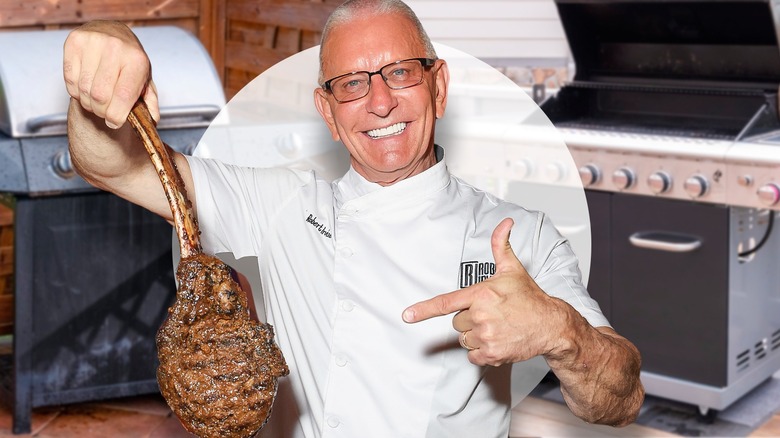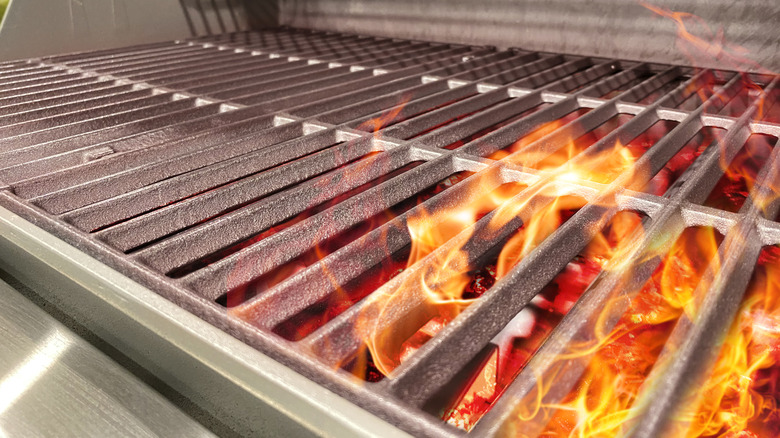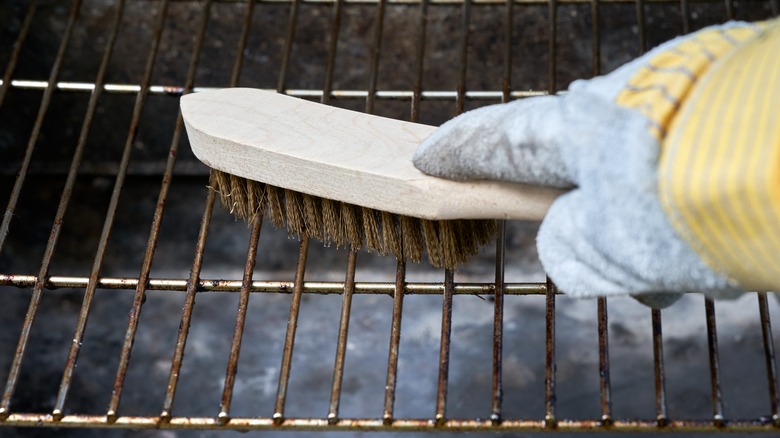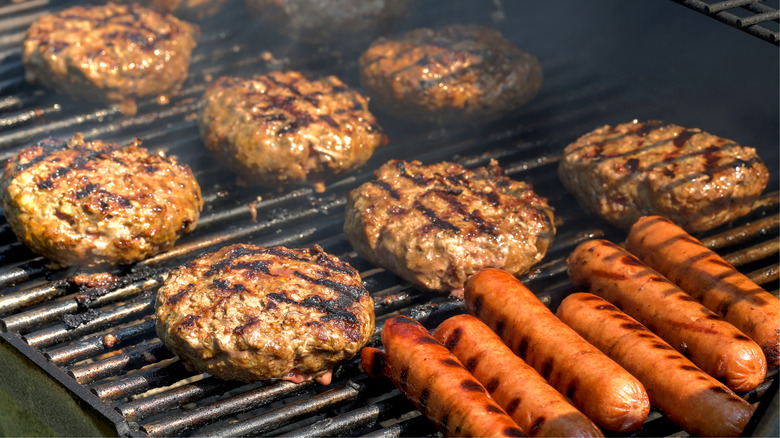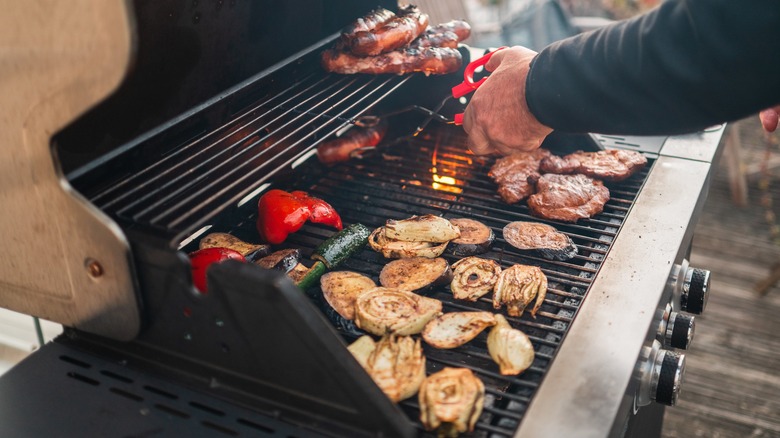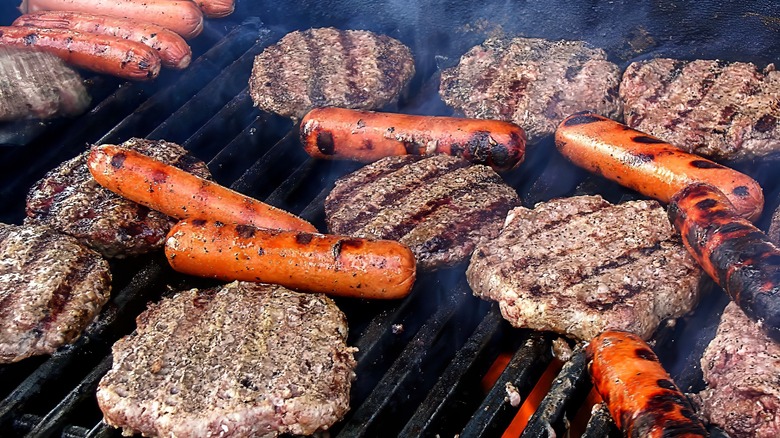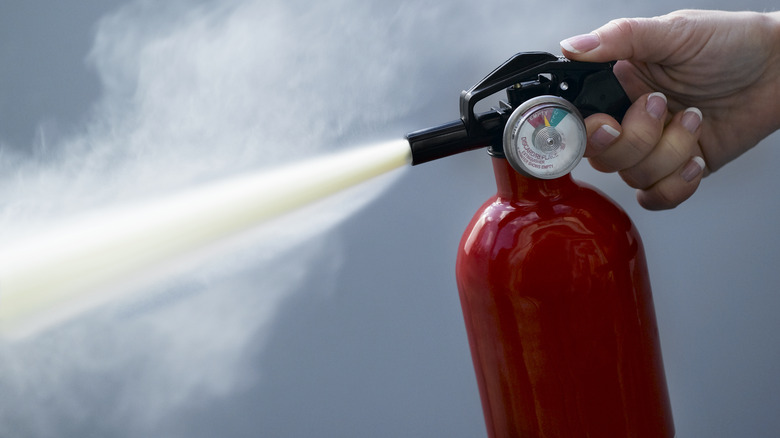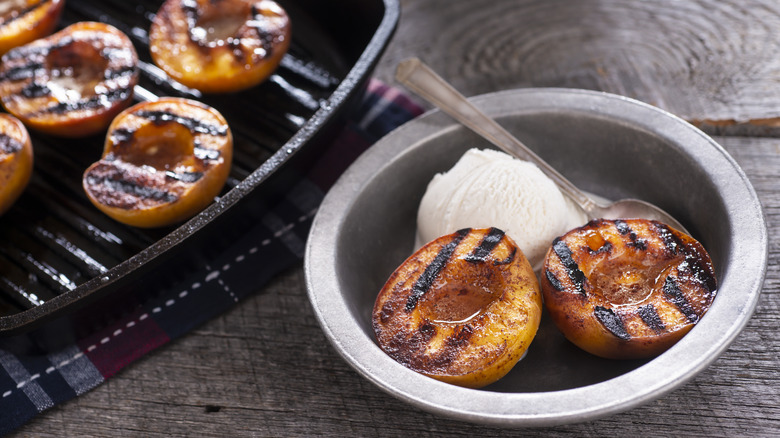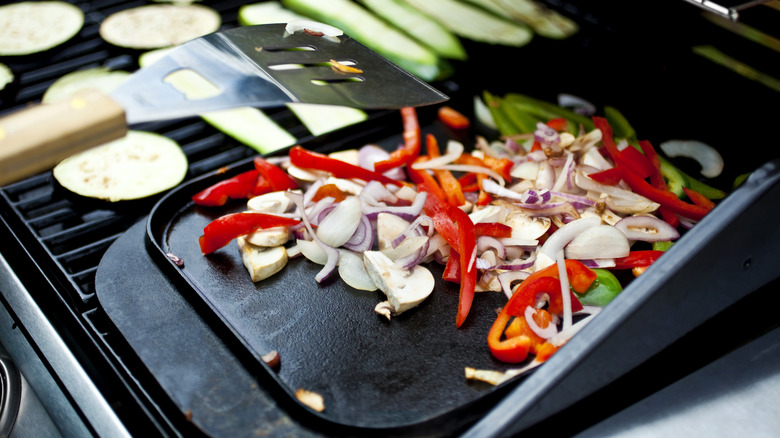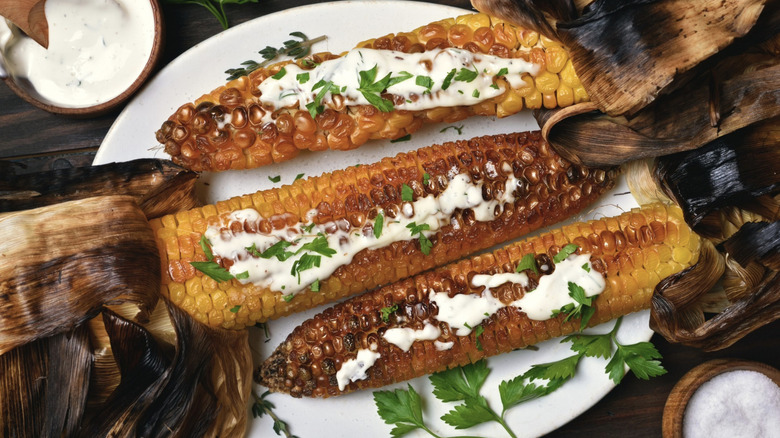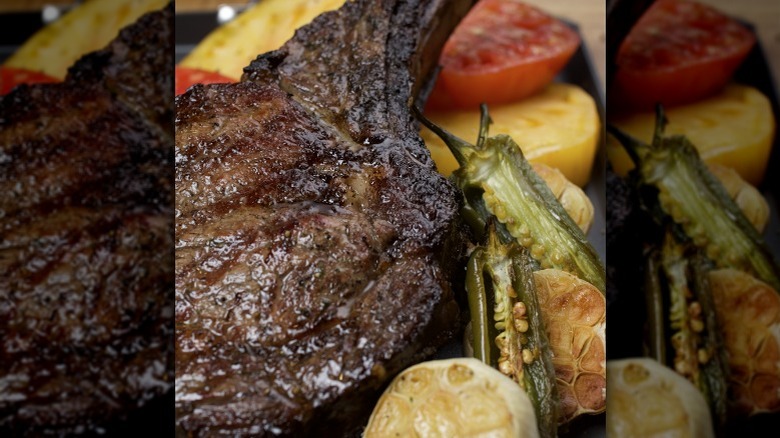Robert Irvine Shares 11 Tips You Need When Cooking With A Gas Grill
For barbecue lovers, the grill is the centerpiece of backyards in the summer. Whether you're using a simple kettle grill or a fully loaded gas grill, food just tastes better when it's cooked over open flames. But understanding the grill you're cooking on can translate to mastering the food you're cooking with. Your gas grill can transform ordinary and simple fare into a grilled gourmet meal, allowing you a chance to serve up recipes such as grilled tandoori pork chops or grilled balsamic flank steak.
To bring you the tips you need when cooking on a gas grill, we connected with Robert Irvine — celebrity chef, cookbook author, successful entrepreneur, and philanthropist. Irvine's passion for cooking and helping others has spread across the globe with his numerous USO tours, eponymous foundation for veterans and first responders, and his own line of prepared foods. Irvine shares with us how to create a grilled sensation at your next barbecue, from grilled burgers and hot dogs to roasted calamari and caramelized peaches.
1. Preheat your grill to achieve the best sear
For some, it goes without saying, but for others, Irvine stresses the need to preheat your grill. One of the biggest grilling mistakes people make is not letting the grill get hot before cooking. He tells us, "I've seen people turn it on and immediately throw their burgers or chicken onto the cold, metal grate, which is a terrific way to get all of your food to stick to the metal and have a huge mess on your hands."
Just like you preheat your oven to bring it up to proper cooking temperature, you should also preheat your grill to get the temperature up for not only getting the perfect sear on your steak but also locking in the juices. "It's the only way to grill," Irvine says. Patience may be hard to come by when you're waiting to sink your teeth into a grilled tomahawk steak, but in this case, patience is your friend.
Getting the perfect sear on your steak means putting room temperature meat on a super-hot grill in order to begin the Maillard reaction that results in the mouthwatering outer crust. How hot? Irvine explains, "When I say hot, I mean very hot; light it up, close the top, and then wait to see the gauge hit 500 or 550 F, because you're going to lose a lot of that as soon as you open it up."
2. Use a grill brush to keep your grill clean
Cleaning your grill versus neglecting it can make the difference between perfectly seared salmon that's easy to lift with a spatula and blackened tuna that gets stuck and appears to melt onto the grate. A clean grill allows you to orchestrate your grilling skills to the fullest. When you're gathering outdoor cooking utensils for manning the grill, don't forget to grab a grill brush for maintaining the grill. It's equally important your grilling utensils are clean, up-to-date, and ready to use. Irvine suggests replacing your grill brush every season, or sooner, as the grease and char build up on the grill's grate.
When determining what other must-have grilling items are needed, Irvine feels simplicity is best. He says, "You just really need four things: spatula, tongs, grill fork, and brush." Treat your outdoor kitchen with the same respect as your indoor kitchen, keeping it clean and functional. Irvine advises, "Every time you're done cooking, and while the grill is still nice and hot, hit it hard with the brush and scraper until it's perfectly clean for the next time."
3. Start with hamburgers and hot dogs if you're new to grilling
Grilling over an open fire may be a daunting challenge if you're only familiar with cooking on an electric stove. If you're not comfortable christening your grilling skills with an expensive cut of meat, like lamb chops or prime rib, Irvine suggests starting with hamburgers and hot dogs. "Hot dogs are practically impossible to screw up on account of the fact that they're fully cooked already; you're just heating them up," he says. Similar to cooking on a gas stove top, start low and slow to heat hot dogs so you don't run the risk of burning them to a charred crisp.
After you've practiced heating hot dogs on your grill, take it to the next level and grill up some hamburgers. Don't worry too much about perfecting the grilled burger right away. After all, Irvine tells us, "If they're too rare, you can put them back on. If they're overcooked, well, at least it wasn't a very expensive mistake." If you're already a pro with grilling hamburgers and hot dogs, stretch your know-how and learn to customize the char levels so you can grill burgers for a crowd.
4. Create two temperature zones on your grill
To grill like a barbecue master or just cook multiple foods at once, it pays to use the two-zone grilling method. Irvine explains, "It's good to create two temperature zones on your grill; keep one side very hot for searing meat, the other side a bit cooler for getting the meat up to temperature or cooking veggies or other sides." The two-zone cooking concept enables you to craft a multi-ingredient meal that can be served at the same time, so your meat doesn't get cold before your sides are done.
Just like your gas stove top has multiple burners for controlling the heat of each dish, your gas grill is set up with multiple heating sections — each with its own knob to control the heat in that section. The only real difference is not having a solid divider in between grilling sections. Adjust your grill's burners accordingly to the food placed on the grate above the flames.
For instance, Irvine says, "You sear a steak under very high heat, but if it's a thick steak, say about an inch or more, that very high heat is going to burn the outside and leave the inside pink." He adds, "So once the sear is done, you want to drop the heat to medium or move it to the other side of the grill that isn't quite as hot."
5. Don't overcrowd the grill
A standard gas grill should cook enough food, including both meat and veggies, for a family of five or six at once; this is another reason why the two-zone grilling method is convenient. "Figure burgers on one side, corn, onions, etc. on the other," Irvine tells us. "Or if you're just doing the meat, and someone else is doing veggies and sides in a conventional oven, you could grill meat for 12." But when you're cooking for a large group of people, don't be tempted to overcrowd the grill as you're cooking. It may hinder the grilling process.
Overcrowding your grill with too much food may keep it from cooking evenly or thoroughly. Irvine warns that it could also increase the risk for a grease fire due to excess oil or fat dripping into the flames, which only fuels the fire. "And it could be one hell of a fire," he adds.
6. Be prepared for a grease fire
Because we can't talk about grilling over open flames without discussing fire smarts, keep safety in mind before you light the grill. Gas grills are a bit more dangerous than charcoal grills, and it's always worth having fire safety equipment nearby when you're grilling. Keep a fire extinguisher or bucket of sand around to safely extinguish a grease fire. Never use water on a grease fire, as this just spreads the fire around.
Inspect your grill before using it to make sure all of the connections are secure and there are no leaks or broken pieces. Set up your gas grill away from items that could potentially catch fire from rogue embers, like your home's siding, low-hanging tree branches, or patio furniture and umbrellas. In the event of a flaming flare-up, being prepared for a potential grease fire is your best offense. Irvine stresses the importance of staying safe. He advises, "If you do get a grease fire, shut off the gas, both the burner knobs, and the tank. Do not play around with that at all."
7. Grill fruit for a special treat
We've been cooking food over fire for hundreds of thousands of years. There's really no shortage of what kind of food you can grill. "I think most things are improved with grilling," Irvine says. "Every kind of meat, seafood, and veggies are better on a grill." Foods that are best to cook on a gas grill cook quickly over controllable flames, like your standard steak, fish, and chicken. But there's no reason to stop there. "Fruit is great, too," Irvine adds.
A number of delicious fruits can be grilled over an open flame to achieve a campfire twist on a simple sweet snack. Irvine shares, "Try grilling a peach for a couple of minutes, watch the sugars caramelize a bit, and then toss a scoop of ice cream on it." Other fruits for grilling include apricots, apples, and pineapple, which pair nicely with meat. Another sweet tip: don't be afraid to add some spice, like chili powder or cayenne pepper, for a contrasting combination of sweet and spicy flavors.
8. Use a cast iron griddle to keep food from falling through the grate
The convenience of a gas grill allows you to grill just about anything thanks to the easily controlled flames. Foods such as steak, fish, pork, and whole veggies and fruit can be cooked directly on the grill grate, but this doesn't mean you're limited to just large pieces of food. With a few accessories at your fingertips, consider your outdoor grill an extension of your indoor stove. Irvine suggests, "Get a square cast iron griddle so you can saute onions or any other side you don't want slipping through the grate."
With a cast iron griddle giving you the opportunity to cook ingredients like julienned onions and peppers, eggs, and hash browns, you can serve up breakfast fresh from the grill. Consider making omelets or breakfast sandwiches with grilled sausage patties or bacon. Beyond that, Irvine says, "Simple food like grilled cheeses and even pancakes get a unique smoky flavor when you cook them on here, too." Might we suggest a French toast grilled cheese?
9. Challenge your skills with grilled calamari
If grilling hot dogs and hamburgers is too simple for you and you'd like more of a challenge, take a walk on the squid-y side. "Most people only know [calamari] as the thing at their pizza place that gets way too much breading," Irvine says. "At that point, it's just fried stuff; the only flavor you get is the breading and the sauce." But calamari has its own unique, slightly sweet flavor that's best highlighted when grilled.
The tender meat of calamari features a light taste. Irvine recommends calamari his favorite way. He tells us, "Grill it with my recipe — which uses paprika, cumin, garlic, and just a couple more things — and that natural flavor comes out. It's a great source of protein, too." Leaving the squid whole, marinate it for a few hours and then grill it over high heat for a couple of minutes on each side. Serve it alongside a salad or dipping sauce.
10. Enhance vegetables on the grill
Vegetables get an extra kick of flavor when they're grilled. But they're not prepared the same as if you were cooking them on your stove top. Similar to roasting in the oven, the thickness of your vegetables matters when grilling. For that reason, some vegetables are better for grilling directly on the grate than others. Vegetables like eggplant, zucchini, and squash can be grilled on the grate whole or cut lengthwise in half. But foods like mushrooms, cherry tomatoes, and green beans are best placed on a grill griddle for cooking.
Grilled corn on the cob is a popular item at summer barbecues. You can leave the husked corn whole or cut it in half or thirds for grilling. Slather corn on the cob with your choice of fat to help keep it from sticking to the grate and grill it for about 15 minutes, rotating it every few minutes. Irvine shares with us his favorite corn on the cob recipe: For grilled Mexican street corn, top your grilled corn on the cob with lime aioli, bacon lardons, queso blanco, and cilantro.
11. Spice up your next grilled ribeye
Ribeye steak lovers get into heated discussions when it comes to the best way to cook this prized cut of beef. Although pan-searing the choice (or prime) cut is the preferred method, we don't know many folks who would pass up a grilled ribeye if it were placed in front of them. A grilled ribeye rarely needs more than salt to finish off the dish and make your mouth water — but if that's the only way you've been grilling and eating ribeye, consider experimenting with your next one.
From dry brining to marinating, there are a number of options for prepping your ribeye for the grill. Most meat lovers top a grilled ribeye with butter, but chef Robert Irvine shares his favorite grilled ribeye recipe, which is sure to spice up your next barbecue and wow your friends. Irvine marinates ribeye steak for a few hours in a mixture of balsamic vinegar, olive oil, and mustard. After grilling it to medium rare, he tops it with grilled jalapeños and garlic, noting that "the garlic should be soft enough to spread like butter."
Static Media owns and operates Tasting Table and Mashed.
